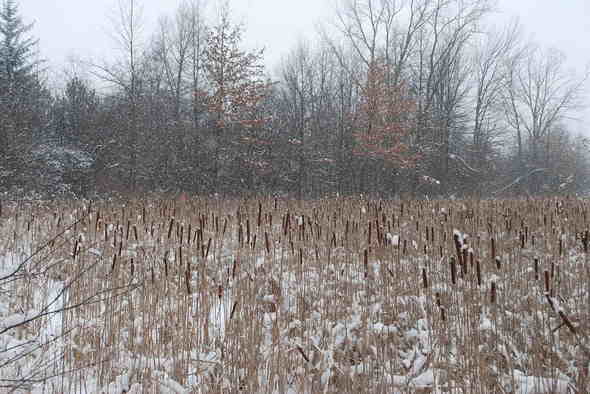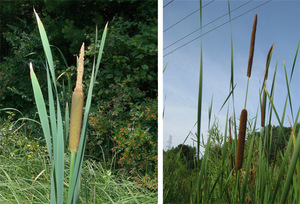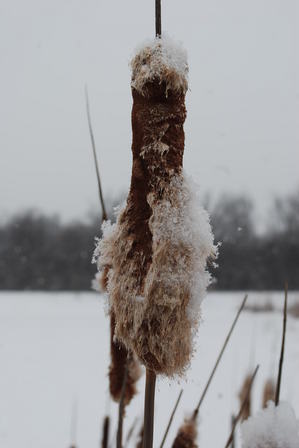Cat-tails: an unsung native that acts like an 'invasive'

A truly native Michigan winter scene - Cat-tails (Typha spp.) get some rest after a gentle snowfall.
Rick Meader | Contributor
If you’re lucky enough to have a wetland, pond, or persistent wet area on your property, there is a very good chance you have cat-tails there. Right now, it is sporting a puffy seedhead and brown leaves. This plant, while not necessarily beautiful, and not popular to all, fills a very important role for some wildlife, so on a cold, snowy day, I thought it would be nice to learn more about it, and how it’s working even now to fill a niche in our winter wonderland.
First, in Michigan, we have two kinds of cat-tail -broad-leaved cattail (Typha latifolia) and narrow-leaved cat-tail (Typha angustifolia) (plus a hybrid between the two Typha xglauca). According to Michiganflora.net, T. angustifolia was introduced to our state. Both are prone to spreading, but in a high quality wetland, you’re more likely to find the broad-leaved cattail.
In the course of researching this article, I also learned that narrow-leaved cat-tail can stand deeper waters than broad-leaved cattails, even two and a half feet or deeper (while broad-leaved prefers water no deeper than 2 and a half feet). They can both do well in shallower water, too, but are wetland obligate, which in layman’s terms means they pretty much have to have their roots in wet soil through the growing season.
They are actually fairly easy to tell apart. First, the leaf. One is broad, and one is narrow. The broad-leaved cattail leaf is about one inch wide, and the narrow-leaved cattail is about half an inch wide. The other way to tell them apart is by their flowering structure. The broad-leaved cat-tail’s male and female sections are together, and the narrow-leaved cattail sections are separated by several inches or so (see the photo).
They are both widely dispersed by seeds, but also spread via rhizome in a given location, and can be form monotypic mats, given the right conditions. These two traits make it undesirable to some, and they certainly behave in an invasive manner.
For muskrats, who feed on the rhizomes and use the dead leaves to build their homes, this means a feeding frenzy, and a veritable free lumber yard, so if you see a good stand of cattails you’re likely to find a muskrat nearby. Red-winged blackbirds also use the plants as perches, but the seeds are not a huge food source for any animal. A dense stand is also not attractive to ducks, but I have seen geese build their nests amongst a stand of them.
According to a detailed website that gives a lot of great information about both of these plants, fires don’t harm the plants as the underground rhizomes aren’t negative affected by the flames, but “geese, herons, egrets and other waterfowl use the burned areas for feeding and nesting." Another interesting site that gives a lot more details about cat-tails is the Lady Bird Johnson Wildflower website.

Broad-leaved cat-tail (Typha latifolia) has its male and female flowers adjoining along the stem, while Narrow-leaved cat-tail (Typha angustifolia) has a large separation between the two.
Photos by C. Peirce (left) and B.S. Walters, Michiganflora.net
Both plants are native to countries around the world. The native ranges of both of these species in North America are pretty similar, according to the U.S. Department of Agriculture. They are both found in virtually every county in Michigan.
With a plant this widespread, you might expect that Native Americans would find a lot of uses for it, and on the University of Michigan-Dearborn ethnobotany database, there are 254 listings of its use by various tribes around the country. Among those uses were food (the rhizomes were ground up and used as a flour and the shoots were eaten like asparagus), medicine (poultices were used to treat wounds, roots were used to treat kidney stones, the tufts were used to reduce chafing for infants, and more), and other purposes (basket making, mats, capes, thatching for tipis and more).
While it’s not always showy, the greenery it provides, the interest in the winter, and the food and cover it provides our furry and feathered friends (plus a few moths whose caterpillars feed on the plant), make it a nice addition to almost any pond or wetland. You don’t need to plant it though. To paraphrase a line from a great movie “Field of Dreams,” provide a consistently wet spot with little or no disturbance, and it will come.

A shaggy old man of winter - a broad-leaved cattail seedhead succumbing to the dispersive forces of nature.
Rick Meader | Contributor
Another thing that’s coming is the annual conference of the Wildflower Association of Michigan. This is a great event to attend, if you have any interest in native plants, ecosystems or butterflies. It’s a two-day event March 3-4 in East Lansing. You don’t have to attend both days, but you might want to.
One of the featured speakers is Douglas Tallamy, the entomologist I’ve written about before who wrote “Bringing Nature Home”, a book that should be read by anyone with a yard of any size, residential, commercial or institutional. Its message, if acted upon by a lot of us, could save a lot of birds and insects from severe population declines as more of our land is converted from natural cover to built or developed landscapes.
In addition to Professor Tallamy, there is a slew of other great, interesting speakers covering a range of subjects, including, to name a few, plant propagation, learning about converting an urban lot into a 100 percent native landscaped deal, and Monarch butterflies. To take advantage of the early bird special, register by this Friday.
It’s been a great, snowy late January, so get out, enjoy the skeletons of winter, and look down in a swampy area to see if you can see the skunk cabbage warming up its surroundings. It’s an outstanding time to be in Michigan!
Rick Meader is a local landscape architect with a special interest in all things natural, including creating designs for homes, businesses and even churches that include a lot of native plants (and the critters they support). You can contact him at yourland1824@gmail.com.


Comments
Susan
Thu, Feb 7, 2013 : 3:05 a.m.
Very interesting article. Thanks!